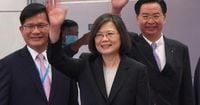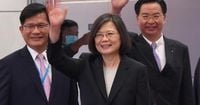Diplomatic tensions in Southeast Asia are once again in the spotlight following a high-profile visit by Taiwan’s foreign minister to the Philippines, a move that has triggered a sharp protest from China and reignited debate over the region’s delicate balance of power. The episode underscores the complex interplay of economics, politics, and national identity at the heart of the South China Sea dispute.
According to multiple reports, including coverage from the Associated Press and Manila Bulletin, Taiwanese Foreign Minister Lin Chia-lung traveled to the Philippines in late August 2025, leading a high-level delegation of investors and business executives from the semiconductor and other key industries. The delegation’s itinerary included stops in Manila and the Clark Freeport Zone, an important industrial hub north of the capital, over a two or three-day period.
While the visit was described by two senior members of Philippine President Ferdinand Marcos Jr.’s Cabinet as being conducted in Lin’s “private capacity,” its timing and composition were anything but low-key. The group was composed of major Taiwanese investors and business leaders, signaling Taipei’s intent to deepen economic ties with its Southeast Asian neighbor. Yet, as the officials emphasized—speaking on the condition of anonymity due to the sensitivity of the matter—Lin did not engage in any official meetings with Philippine political or security officials during his stay.
The Philippines, for its part, has walked a careful diplomatic tightrope. Under its longstanding “One China” policy, Manila does not recognize Taiwan as a sovereign state. Instead, it acknowledges Beijing’s claim that Taiwan is a part of China, a position that has guided Philippine foreign policy for decades. However, the Department of Foreign Affairs in Manila was quick to clarify that economic and people-to-people contacts with Taiwan—including in areas such as trade, investment, and tourism—are maintained “within the bounds of our One China Policy.” As the department stated, “no official from Taiwan was recognized as a member of the business delegation that recently visited the Philippines,” an assertion intended to distance the government from any suggestion of formal diplomatic engagement with Taipei.
China, however, was not mollified. The Ministry of Foreign Affairs in Beijing issued a strongly worded protest both in Manila and Beijing, condemning the Philippines for what it called providing a platform for “Taiwan independence separatists to engage in anti-China activities.” The Chinese government accused the Philippines of “severely violating its own commitment on Taiwan-related issues,” and warned Manila to “stop pursuing the wrong course and return to the right track at once, stop playing with fire on issues concerning China’s core interests.”
In a particularly pointed statement, the Chinese foreign ministry cautioned, “There is a price to pay for trampling on China’s red line, and all consequences arising therefrom will be borne by the Philippines.” The rhetoric highlights Beijing’s deep sensitivity to any perceived erosion of the One China principle, especially in the context of rising tensions with both the United States and regional neighbors over Taiwan’s status and the broader South China Sea disputes.
According to Manila Bulletin, the Chinese foreign ministry spokesperson went further, accusing the Philippine government of a “serious lack of credibility” and reiterating that “Taiwan remains an inalienable part of China’s territory.” The spokesperson insisted, “The Taiwan question is China’s internal affair,” and urged the Philippines to “abide by the one-China principle and the joint communiqué on establishing diplomatic ties between China and the Philippines.”
The Philippines’ response has been one of careful ambiguity. The Department of Foreign Affairs neither confirmed nor denied Lin’s reported visit, reiterating instead that “no official from Taiwan is recognized as a member of the business delegation that recently visited the Philippines.” This statement aligns with the government’s official stance, seeking to maintain beneficial economic relations with Taiwan without crossing Beijing’s diplomatic red lines.
The backdrop to these events is the increasingly fraught relationship between China and the Philippines, particularly as their coast guards and other forces have engaged in tense confrontations over disputed islands and fishing grounds in the South China Sea. The region is a flashpoint for broader geopolitical rivalries, with the United States frequently expressing support for the Philippines and other Southeast Asian nations in the face of what it calls Chinese coercion.
For Taiwan, the visit by Foreign Minister Lin Chia-lung and his business delegation represents a strategic effort to bolster economic ties in the region, especially in sectors like semiconductors where Taiwanese firms are global leaders. While the visit was officially described as private, its significance was not lost on observers in Beijing or Manila. Economic outreach is one of the few avenues available to Taipei to maintain its international presence, given the diplomatic isolation imposed by Beijing’s insistence on the One China policy.
For the Philippines, the stakes are high. Manila must balance its economic interests in engaging with Taiwan—an important trading partner and source of investment—against the risk of provoking Beijing, its largest trading partner and a regional superpower. The government’s carefully worded statements and refusal to publicly acknowledge Lin’s visit as official reflect this delicate balancing act.
China’s reaction, meanwhile, is part of a broader pattern of assertive diplomacy aimed at deterring any moves that could be interpreted as support for Taiwanese independence. The warning that “all consequences arising therefrom will be borne by the Philippines” is a stark reminder of the potential costs for countries in the region that stray from Beijing’s preferred script.
Yet, despite the tough talk, the reality on the ground is more nuanced. Economic ties between Taiwan and the Philippines continue, with trade, investment, and tourism flowing across the unofficial divide. The Philippines’ approach—engaging with Taiwan in the economic sphere while insisting on adherence to the One China policy—reflects the pragmatic choices faced by many countries navigating the region’s geopolitical currents.
As tensions simmer and diplomatic statements fly, the episode serves as a microcosm of the broader challenges confronting Southeast Asia. The region’s leaders must constantly weigh the benefits of economic engagement, the imperatives of national sovereignty, and the realities of great power rivalry. For now, the Philippines appears determined to walk this diplomatic tightrope, hoping to reap the rewards of economic cooperation without incurring the wrath of its powerful neighbor to the north.
How long this balancing act can be sustained remains an open question, but for now, Manila’s careful diplomacy has kept the door open to both sides—even as the temperature in the region continues to rise.


